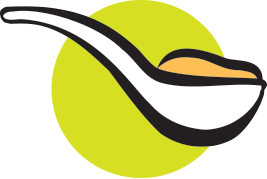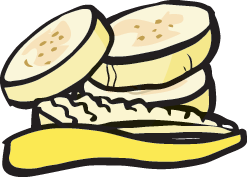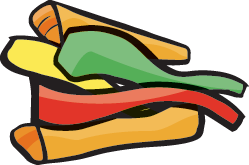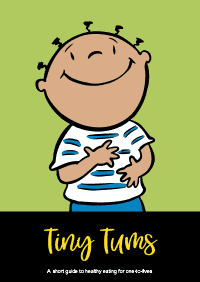
A short guide to introducing baby’s first foods
Baby Steps
introducing first foods
The Department of Health recommends introducing complementary feeding at around six months.

Complementary feeding, or weaning, is the gradual introduction of solid foods to a baby’s diet. For most babies, breastmilk or infant formula can meet their needs for growth until around 6 months. As they get older, they need more nutrients and energy from food to help them grow and develop well.
During this time, babies experience new tastes and textures to help them develop new feeding skills. This booklet will help to guide you as you introduce your baby to their first foods and beyond.
When is it best
to start?
Let your baby guide you. Start at around 6 months, when your baby is showing these 3 signs that they are ready:
- They can sit with some support and hold their head steady
- They can coordinate lifting food and putting it in their mouth
- They can swallow food and not push it back out
Introduce these foods around 6 months and one by one:
- milk and dairy foods
- eggs
- foods containing wheat or gluten
- smooth peanut butter and other nut butters
- well cooked fish and shellfish
If your child tolerates these foods and shows no signs of allergy, keep offering them as part of your baby’s regular diet to minimise the risk of developing a food allergy.
Pre-term babies
If your baby was born prematurely, ask their medical team for guidance. The appropriate age for introducing first foods will depend on how prematurely your baby was born.
See www.bliss.org.uk for further information on weaning premature babies.
Where to
begin?
Some babies will be ready to move on to mashed and finger foods immediately, whereas others may prefer smoother foods from a spoon. Offer both so that your baby learns both types of feeding skills.
Start slowly – try a few finger foods or baby feeding spoons of:

baby cereal mixed with breastmilk or infant formula (e.g. porridge).

puréed or mashed soft ripe or cooked fruit or cooked vegetables or family meals without salt (e.g. potato, yam, parsnip, apple or pear – cool before eating)

soft ripe or cooked fruit as finger food (e.g. banana, mango, melon or avocado)

soft, cooked vegetables as finger food (e.g. carrot, broccoli florets, sweet potato)
What next?
Go for textures
Gradually introduce foods with soft lumps so your baby learns to manage foods with different textures.
Finger foods
Cut up foods into pieces big enough for your baby to hold in their fist, with a bit sticking out at the top. Pieces about the size of your own finger work well.
New foods
Gradually introduce more new foods! Try soft cooked meat, lentils, and hard boiled eggs as your baby needs the iron in these foods. Combine them with vegetables and pasta or rice.
Go for variety
Offer different foods on different days. Babies take time to learn to like new foods – this is completely normal – so keep offering foods they might not seem to like at first.
Now is the time
Introduce dairy foods made from whole milk such as plain yogurt, fromage frais and cheeses (e.g. mild cheddar, cottage cheese or cream cheese). Whole milk can be used as an ingredient in recipes such as porridge, unsweetened custard or cheese sauce.
Cups
Introduce an open cup or free flow cup (with no valve), and offer sips of water with meals. This will help your baby learn to sip and is better for their teeth. Aim to discontinue bottles around their first birthday.
Vitamins
The Department of Health recommends that babies take a vitamin D supplement from birth. Infant formula is fortified with vitamin D so healthy babies having 500ml or more a day don’t need this supplement. Vitamins A and C are also recommended from age 6 months onwards.
Do it in steps
Gradually increase the amount and variety of foods your baby eats until they can eat 3 small family meals a day, with no added salt or sugar.

Foods
to take care with
Consult your health visitor if you have concerns about allergy.
Foods that can cause allergies (e.g. milk, eggs, nuts, wheat, soya, fish, sesame), and foods containing these ingredients, should be introduced one at a time giving the food each day for 3 days so you can spot a reaction. If your baby has moderate to severe eczema, speak to your healthcare professional before introducing foods from the list above.
Soya-based infant formula and soya products should only be used if advised by your healthcare professional, as babies who are allergic to cow’s milk may also have other allergies.
Choking is rare in young babies
But take care before giving foods to your baby.
- Cut small round foods in quarters, lengthwise, e.g. grapes or cherry tomatoes
- Peel and lightly cook hard fruits and vegetables e.g. apples and carrots
- Cut cheese into sticks rather than cubes
- Remove any stones or pips
- Remove skin and bones from fish, meat and meat products e.g. chicken
Always stay with your baby when they are eating in case they start to choke.
Gagging is a totally normal reflex during weaning. Take a look at this NHS page to find out the difference between choking and gagging, and what to do if your child chokes.
Not for little
tums.
Sugar
Your baby does not need added sugar. Avoiding sugary foods and drinks will help prevent tooth decay.
Sweetners
Sweeteners are not suitable for babies and young children.
Honey
Do not introduce before the age of one as it sometimes contains a bacteria that can produce toxins, and may lead to infant botulism.
Salt
Do not add salt to your baby’s food. Use herbs and spices rather than salt to flavour food.
Whole Nuts
As they may cause choking. You can use nut butters and finely ground nuts in food.
Foods intended for adults
e.g. low-fat and low-sugar foods. Raw or undercooked fish or meat
Swordfish, marlin and shark
The amount of mercury in these fish can affect a baby’s growing nervous system.

Top tips
First foods
Handy hints
-
Make batches of mashed or puréed food and freeze in ice-cube trays or containers
-
Defrost cubes as required in the fridge overnight or defrost in the microwave
-
Reheat food thoroughly until hot all the way through
-
Remember to let food cool down before offering it to your baby.

Allow your baby to feed themselves using their fingers, as soon as they show an interest.
It can get messy but this is an important part of your baby’s development.
Offer water in an open cup or free flow cup (without a valve) with all meals.
Continue to offer breastmilk or formula milk feeds but allow your baby to gradually reduce the amount of milk drunk as he or she starts eating more food.
Never leave your baby alone with a bottle, or prop up their bottle, as it could cause choking.
Milky Matters

Only breastmilk or infant formula should be given as a main drink for under-ones. As babies start to eat more solid food, they’ll naturally need fewer milk feeds and will drop them gradually.
‘Follow-on’ formula can be introduced only after 6 months but it is not necessary to move your baby on to these milks.
Whole cow’s milk can be given as a drink once your child is 1 year old.
Milk-based puddings like yogurt or rice pudding are good milky options.
You may choose to continue giving your baby breastmilk alongside family foods for as long as it suits you and baby.
Milk-like drinks are not nutritionally similar to cow’s milk, and may be low in protein and other important nutrients. If your little one has a cow’s milk allergy, speak to a Registered Dietitian for advice.
Rice drinks aren’t suitable for children under 5 because of the levels of arsenic they may contain. Other alternatives to cow’s milk may be served after your child is 1 year old.
From
seven to nine months on
Offer your baby 3 meals a day, in addition to breastmilk or formula.
Infants of this age should still be given milk feeds responsively, but may want about four feeds a day.
They will be having a mixture of soft finger foods, mashed and chopped foods.
Each day try to give your baby a variety of foods including:
- Fruit and vegetables
- Starchy foods (e.g. potatoes, rice, pasta, couscous, quinoa and bread)
- Meat, fish (well-cooked, no bones), well-cooked eggs, pulses (peas, beans or lentils and nut butters)
- Whole milk and dairy products. Foods made from whole milk, such as unsweetened yogurt, fromage frais and custard. Whole milk can be used in cooking or added to other foods such as cereal.
Feeding
a one year old
Your baby can join in with the family by eating 3 meals a day by their first birthday.
Try and make their diet as varied as possible.
Whole milk can now be introduced as a main drink. Milk should be given in a cup.
Each day, try to give your child:
- Starchy foods at each meal (e.g. potatoes, pasta, rice, couscous, quinoa, bread)
- A variety of protein 2 servings of meat, fish eggs, beans and lentils or nut butters
- Fruit and vegetables Encourage your child to try lots of different fruit and veg. Include them in all meals. Try adding banana or grated apple to breakfast cereal or carrots or red pepper to pasta sauces to boost servings
- Whole milk and dairy 3 servings a day as a drink, in milk-based recipes, or as cheese, unsweetened yogurt or fromage frais.
Safe food
Top tips for keeping baby food safe
-
Keep all utensils and surfaces clean.
-
Wash your hands and your baby’s hands before meals.
-
Thoroughly wash all bowls and spoons for feeding.
-
Peel or wash fruit and veg.
-
Throw away half-eaten food that’s been previously prepared.
-
When heating up food, always stir it well and make sure it’s steaming all the way through.
-
Cooked food can be stored in the fridge for up to 24 hours but do not reheat it more than once.
-
Cook all food thoroughly and check the temperature before offering food to your baby.

Snack
attack
Babies under 12 months do not need snacks – if you think your baby is hungry between meals, offer extra milk feeds instead. From 12 months, you can add 2 snacks in between meals

Snack ideas for your one-year-old:
-
Canned fruit in fruit juice
-
Soft, peeled fresh fruit
-
Plain yogurt with sliced grapes
-
Hard cheese (sliced or cut into sticks) and sliced tomatoes
-
Pitta or chapatti fingers
-
Unsalted and unsweetened rice cakes
-
Pepper sticks
Your questions
answered
Should I give my baby fruit drinks, squash or fruit juice?
Fruit juices are a good source of vitamin C but they also contain natural sugars and acids which can cause tooth decay.
Babies under 12 months don’t need fruit juice or smoothies. If you choose to give these to your baby, restrict them to mealtimes and dilute one part juice to 10 parts water to minimise risk of tooth decay.
The best drinks to give between meals are breastmilk, infant formula, or water. All water should be boiled and then cooled for babies under six months. Bottled water is not sterile and may contain too much sodium (salt).
When should I switch my baby from a bottle to a cup?
Introduce an open cup or a free-flow cup (with no valve) when your baby is six months old. Try and finish with the bottle by his or her first birthday. Prolonged bottle feeding may damage teeth.
Should I give my baby ready-made baby food?
Jars of ready-made baby food are convenient, but portion sizes are often too big and much of it has the same texture. Homemade baby food is usually cheaper and made from simple ingredients. If you do buy ready-made food, look at the ingredients label to check that it does not contain added sugar or salt. Don’t reuse food that your child has half-eaten.
Can I give my baby low-fat foods?
No, save low-fat foods for later in life. Babies need fat- and fat-soluble vitamins, like vitamin A, to help them grow and develop. For example, choose yogurts made from whole milk.
How can I make sure my baby gets enough iron?
Babies are born with a store of iron that will last about six months. After that they need to get iron from their food. Red meat is the best source of iron e.g. beef, and dark poultry meat such as thigh or leg meat. Other foods such as eggs, lentils and beans work best when given alongside vitamin C rich foods such as tomatoes, broccoli and fruit.
Is it OK to give my baby goat’s or sheep’s milk?
These can be used in cooking after 6 months but not as a drink until age 1 year as they don’t contain all the nutrients that babies need.





